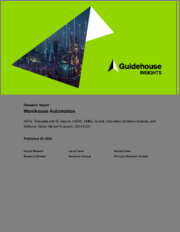
|
시장보고서
상품코드
1524071
창고 자동화 - AGV, 캐러셀 컨베이어, AS/RS, AMR, 코봇, 자동 분류 시스템, 소프트웨어: 세계 시장 예측(2024-2033년)Warehouse Automation - AGVs, Carousels and Conveyors, AS/RS, AMRs, Cobots, Automated Sortation Systems, and Software: Global Market Forecasts, 2024-2033 |
||||||
코로나19 팬데믹 이후 소비자의 구매 습관은 창고 업계가 더 빠른 속도로 제품을 생산하도록 압력을 가하고 있습니다. 창고를 소유한 기업이나 창고를 통해 배송하는 기업들은 소비자의 기대에 부응하기 위해 야간 배송과 당일 배송을 당연시하고 있습니다. 이러한 수요를 충족시킬 뿐만 아니라 창고 운영의 효율성과 정확성을 높이기 위해 창고 업계는 반복적이고 힘든 프로세스의 자동화에 착수하고 있습니다. 이는 창고 자동화 산업의 전반적인 성장으로 이어지고 있습니다.
그러나 창고 자동화 기술 시장은 아직 초기 단계에 있으며, 광범위한 보급이 이루어지기 위해서는 여러 가지 과제를 극복해야 합니다. 창고 자동화 통합의 이점에 대한 인식이 낮은 반면, 다양한 자동화 기술 도입 비용이 높기 때문에 인건비가 저렴한 지역에서는 ROI 측면에서 이러한 기술이 적합하지 않을 수 있습니다. 또한, 지난 몇 년동안 창고 자동화 기술이 개선되었지만, 창고 공간 내에서 인간이 이러한 기술과 얼마나 잘 협력하고 소통할 수 있는지에 대해서는 여전히 격차가 있습니다.
이 보고서는 세계 창고 자동화 시장을 7가지 기술 분야(무인운반차(AGV), 캐러셀 컨베이어, 자동 보관 및 검색 시스템(AS/RS), 자율 이동 로봇(AMR), 협동 로봇(코봇), 자동 분류 시스템, 소프트웨어)로 분류하여 분석하였습니다. 또한 시장 성장 촉진요인과 억제요인을 고찰하고, 창고 자동화 기술의 보급 확산을 위한 업계 이해관계자들에 대한 제안을 수록했습니다. 또한, 향후 시장 수익 동향 전망(2033년까지)을 기술별, 지역별(북미, 유럽, 아시아태평양, 라틴아메리카, 중동/아프리카), 산업별(소매, 의료/제약, 운송, 식음료, 전자제품, 기타)로 예측했습니다.
목차
제1장 주요 요약
제2장 시장 문제점
- 기술
- 무인운반차(AGV)
- 캐러셀 및 컨베이어
- 자동 보관 및 검색 시스템(자동 창고, AS/RS)
- 자율 이동 로봇
- 협동 로봇
- 자동 분류 시스템
- 소프트웨어
- 성장 촉진요인
- 성장 억제요인
- 가격
제3장 업계 상황
- 경쟁 구도
- 산업 밸류체인
제4장 시장 예측
- 세계 시장 예측 : 기술별
- 세계 시장 예측 : 업계별
- 지역별 시장 예측 : 기술별
- 북미
- 유럽
- 아시아태평양
- 라틴아메리카
- 중동 및 아프리카
제5장 결론 및 제안
- 3대 포인트
- 제안
- 창고 자동화 제공업체
- 창고에 보관되고 있는 제품 제조업체
- 창고 소유자 및 운영자
제6장 두자어 및 약어 리스트
제7장 목차
제8장 도표
제9장 조사 범위
제10장 정보 출처와 조사 방법/주석
LSH 24.08.09Since the COVID-19 pandemic, consumer purchasing habits have placed increased pressure on the warehouse industry to churn out products at a faster rate. Companies that own warehouses or ship through warehouses have made overnight and 1-day shipping commonplace to meet consumer expectations. To satisfy these demands as well as increase the efficiency and accuracy of warehouse operations, warehouses have increasingly started automating repetitive and strenuous processes. This has led to overall growth in the warehouse automation industry.
However, the market for warehouse automation technologies is nascent, and numerous challenges must be overcome before widespread adoption can be expected. Awareness of the benefits of integrating warehouse automation is low, the cost of implementing many of the automation technologies is high, and the ROI for these technologies may not be worthwhile in regions where human labor is cheap. Further, while warehouse automation technologies have improved over the last few years, there are still gaps in how well humans can collaborate and communicate with these technologies within the warehouse space.
This Guidehouse Insights report analyzes the global market for warehouse automation for seven technologies: autonomous guided vehicles (AGVs), carousels and conveyors, automated storage and retrieval systems (AS/RS), autonomous mobile robots (AMRs), collaborative robots (cobots), automated sortation systems, and software. The report discusses market drivers and barriers and issues recommendations to industry stakeholders for increasing the adoption of warehouse automation technologies. Revenue forecasts through 2033 are segmented by technology, global region (North America, Europe, Asia Pacific, Latin America, Middle East & Africa), and industry (retail, health and pharmaceuticals, transportation, food and beverage, electronics, other).
Table of Contents
1. Executive Summary
- 1.1 Introduction
- 1.1.1 Scope
- 1.1.2 Market Drivers
- 1.1.3 Market Barriers
- 1.2 Global Market Outlook
2. Market Issues
- 2.1 Technology
- 2.1.1 Autonomous Guided Vehicles
- 2.1.2 Carousels and Conveyors
- 2.1.3 Automated Storage and Retrieval Systems
- 2.1.4 Autonomous Mobile Robots
- 2.1.5 Collaborative Robots
- 2.1.6 Automated Sortation Systems
- 2.1.7 Software
- 2.1.7.1 Control Software
- 2.2 Drivers
- 2.2.1 Increased Warehouse Productivity
- 2.2.2 Less Human Error and Improved Accuracy
- 2.2.3 Reduced Warehouse Injuries
- 2.2.4 Reduced Labor Costs
- 2.2.5 Improved Scalability
- 2.3 Barriers
- 2.3.1 Cost of Technology
- 2.3.2 Maintenance and Downtime
- 2.3.3 Integration with Existing Systems and Communication Limitations
- 2.3.4 Employee Objection to Warehouse Automation
- 2.3.5 Goods Packaging
- 2.4 Pricing
3. Industry Landscape
- 3.1 Competitive Landscape
- 3.2 Industry Value Chain
4. Market Forecasts
- 4.1 Global Forecasts by Technology
- 4.2 Global Forecasts by Industry
- 4.3 Regional Forecasts by Technology
- 4.3.1 North America
- 4.3.2 Europe
- 4.3.3 Asia Pacific
- 4.3.4 Latin America
- 4.3.5 Middle East & Africa
5. Conclusions and Recommendations
- 5.1 Three Big Takeaways
- 5.2 Recommendations
- 5.2.1 Warehouse Automation Providers
- 5.2.2 Manufacturers of Products Stored in Warehouses
- 5.2.3 Warehouse Owners and Operators



















